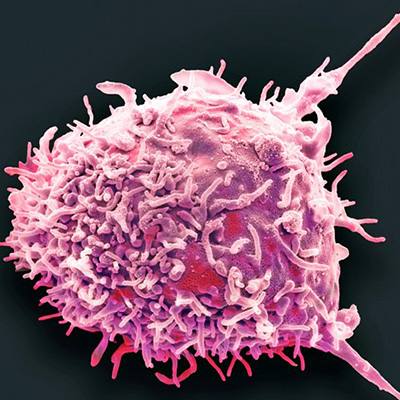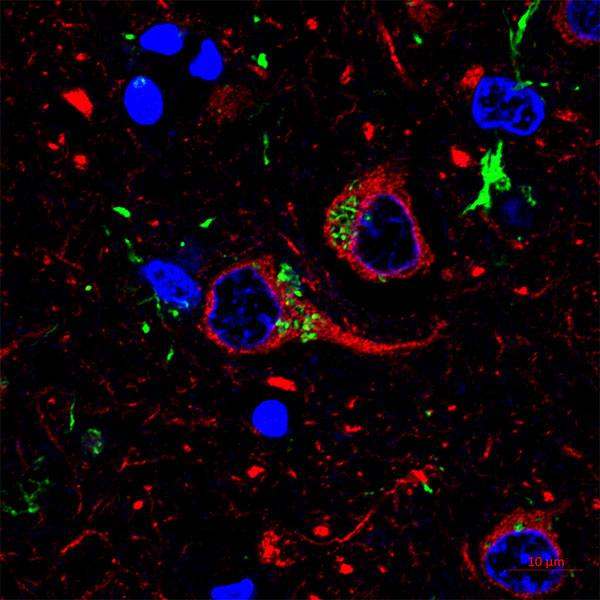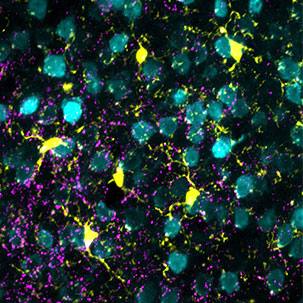-
Discovery Science
Discovery’s Edge: A full-court press on understanding and preventing glaucoma
A lifelong basketball player and coach who tops out at 6 feet 6 inches, Michael P. Fautsch, Ph.D., understands the importance of applying pressure defense to his research on glaucoma, the leading cause of blindness worldwide. With his colleagues in Mayo Clinic's Department of Ophthalmology, Dr. Fautsch is pressing the attack on glaucoma from all angles, investigating the cellular, molecular and anatomical underpinnings of the disease.
At the same time, Dr. Fautsch is developing a new class of compounds that both lowers intraocular pressure and helps protect the tissues of the eye from further damage.
"This could be the first drug class that has a dual role," he says. "It could really be a huge advance in treatment."
Nearly 4 million people in the United States have glaucoma, the National Eye Institute estimates, yet the last new Food and Drug Administration-approved drug for glaucoma hit the market in 2001.
Because some drugs don't work well for every patient, Dr. Fautsch wants to remedy the lack of treatment options. The first hurdle, however, is developing a better understanding of glaucoma itself.
In the most common form of glaucoma, the eye's drainage canal — the trabecular meshwork—becomes less efficient, causing an increase in internal (intraocular) eye pressure. If not treated, the increased pressure can damage the optic nerve, causing irreversible blindness.
"The idea of elevated intraocular pressure has been around for 125 years, and for the last 125 years investigators have been trying to find exactly what happens in the glaucoma eye that's different than the normal eye," Dr. Fautsch says. "My research not only looks at developing new treatment ideas but also at the development of the disease."
An early interest in science
For Dr. Fautsch, the drive to uncover the molecular workings of cells began in eighth grade, when his father was diagnosed with nasopharyngeal cancer.
"Seeing him going through numerous radiation treatments and his fight to beat the disease was inspiring," Dr. Fautsch says. His first science fair project compared cancer cells with normal cells, sparking a lifelong love of biology.
Dr. Fautsch credits his parents with instilling in him a strong work ethic. In high school, he landed a spot as a phlebotomist on the morning shift at the local hospital in Spring Lake Park, Minn., thanks to prior training as an emergency medical technician. From 5 a.m. to 8 a.m., he was at the hospital drawing blood. After school, he practiced with the basketball team, and he squeezed in homework at night.
That work ethic has served him well. It has allowed him to jump research fields multiple times, a rare feat in the increasingly specialized world of science.
Dr. Fautsch first trained as a molecular biologist with Eric D. Wieben, Ph.D., a genetics researcher at Mayo Clinic in Rochester, Minn. He then switched to thoracic medicine, with a postdoctoral fellowship under the guidance of Edward B. Leof, Ph.D., a researcher in pulmonary and critical care medicine at Mayo Clinic in Rochester. The final shift was to ophthalmology in 1999, when the late Douglas Johnson, M.D., then research chair of the department, came calling.
After joining the Ophthalmology Department, Dr. Fautsch again learned the basics of a new field of medicine. His first studies included delineating the differences between normal eyes and those with glaucoma.
For example, the aqueous humor supplies all the nutrients to tissues in the front of the eye, yet very little is known about it, he says. Dr. Fautsch found that myocilin, the first gene linked to several forms of glaucoma, is elevated in aqueous humor isolated from patients with primary open-angle glaucoma.
The gene's function is still unknown, but he and many others are interested in unraveling the function. In a paper published in Investigative Ophthalmology and Visual Science in 2010, Dr. Fautsch and his colleagues identified nearly 700 proteins in normal aqueous humor, eight times the amount known up to that point.
"If we knew what was in the normal fluid, we could compare samples taken from different types of glaucoma and identify molecules that could potentially be used for diagnosis and treatment," he explains.
World's experts
Current treatments for glaucoma essentially slow the disease's progression. However, improved therapies are continually being pursued.
Pharmaceutical and biotech companies have come to Mayo Clinic to test their drugs and devices on the Department of Ophthalmology's unique model — an anterior segment perfusion organ culture model. This human model replicates what happens in the front of the eye. Created by Dr. Johnson in the late 1980s, it's the first and only type of human organ model that looks at elevated intraocular pressure.
"We are the world's expert," Dr. Fautsch says.
Members of the Department of Ophthalmology travel worldwide to train other researchers in setting up similar model systems, while researchers also visit Mayo Clinic to observe the research. Using the models, researchers can test compounds, proteins and surgical devices to see if they affect fluid flow through the eye's trabecular meshwork.
"For over 80 years, researchers have debated whether intracranial pressure contributes to development of glaucoma," Dr. Fautsch says.
Recent studies with collaborators at Duke Eye Center, the University of North Carolina at Chapel Hill and Vance Thompson Vision indicate that people with primary open-angle glaucoma tend to have decreased intracranial pressure compared with those without glaucoma.
Dr. Fautsch is at work on his own unique model so that he can learn more about what happens to the optic nerve in glaucoma.
He is developing the first animal model to measure intracranial pressure in real time. Cerebral spinal fluid may cause lower than normal intracranial pressure at the back of the optic nerve, resulting in a pressure imbalance with the front of the eye that can cause some types of glaucoma. There are no models to evaluate what may be a risk factor for this condition.
Another of Dr. Fautsch's discoveries came in 2008, when he began combing the scientific literature to grasp the basic science underpinning potential drugs for glaucoma. His first stop was a class of potassium channels regulated by adenosine triphosphate (ATP).
"I thought it fit," he says. "The functions that are regulated by ATP-sensitive potassium channels are also known to potentially affect fluid flow through the trabecular meshwork. I tested some pharmaceutical compounds that are known to regulate their function, and lo and behold, they had ocular hypotensive activity."
The pharmaceutical compounds, called ATP-sensitive potassium channel openers, not only lower fluid pressure in the eye but also seem to protect cells in the retinal ganglion and trabecular meshwork, the two main sites of injury during glaucoma.
Discovering treatments to reduce pressure and protect cells is a goal of Dr. Fautsch's research, but the focus of study also has personal meaning. Seven years ago, his father, now a 40-year cancer survivor, developed a temporary episode of acute glaucoma.
A community of collaborators
Many barriers remain before the compounds are ready for clinical use.
For example, the compounds can't be applied directly into the eye because they are not able to be dissolved directly into the eye. With Mayo Clinic's Michael F. Romero, Ph.D., professor of physiology, Dr. Fautsch is working to synthesize a formula that can be used topically.
Dr. Fautsch is optimistic about the potential drug due to its cell-protective properties.
"We are hoping this will positively advance treatment for glaucoma," he says.
Collaborations are common in eye research at Mayo Clinic.
"We try to combine an M.D.- and a Ph.D.-approach to answering questions," says Sanjay V. Patel, M.D., the chair of Mayo Clinic's Department of Ophthalmology.
For example, Drs. Patel and Fautsch were awarded a research grant from the National Eye Institute to investigate corneal endothelial cell transplantation.
"I have an interest at the clinical level, but getting down to the molecular level, I need Mike's help," Dr. Patel says.
The department is expanding its research program by adding more full-time scientists to the faculty, increasing the flow of new knowledge.
"We've got eager clinicians," Dr. Patel says. "We need to keep the department at the cutting edge of treatment, and part of that will develop from our research program."







